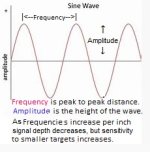ToddB64: said:
Hi All ! 
Attached are a two graphic images showing sinewaves of two different coil signal frequencies. These sinewaves are representative of the coil signals produced by single frequency metal detectors like my White's Classic II 6.5 kHz frequency (wide peak-to-peak distance) and my Tesoro Compadre's 12 kHz (more narrow-compressed peak-to-peak distance).
Good info. First, to clarify, the White's Classic II, like all the other Classic models and most White's models from about 1980 to the XLT in '94 and on to the XL Pro around 2000, were initially labeled as 6.
592 kHz. Later they rounded that to 6.
59 kHz and then rounded it to 6.
6 kHz. It wasn't 6.5 kHz.
The Compadre, as you noted, operates at 12 kHz which was just about where the noted engineer, George Payne, determined an optimal 'general-purpose' Frequency to be for detection ability from lower-conductive gold jewelry to US Nickels and on up the Copper Cents and assorted Silver coins. That 'optimal' 'general-purpose' Frequency was 12.
5 kHz.
ToddB64: said:
As you see from the graphic illustrations, when the Frequency increases, for example from 6.5 kHz to 12 kHz, the peaks become more compressed, resulting in more sinewave peaks per inch.
Okay, but for most forks that doesn't answer much with regard to their detector performance. If you connect it with a design engineer's description it basically translates to this:
Usually the lower-frequencies
may have
a little better responsiveness to higher-conductive coins, such as silver or copper, and they
might also handle
some ground mineral better and
possibly provide
a little increase in detection depth.
The other extreme from a ±5 kHz operating Frequency, such as those operating with a Frequency of about 20 kHz to 25 kHz,
may have
a little better responsiveness to lower-conductive coins, such as a US Nickel, as well as small, thin Gold Jewelry, etc. And they
might also handle
some ground mineral better and
possibly provide
a little decrease in detection depth.
So the 'ideal' general-purpose operating Frequency would be 12.
5 kHz, and since the late '70s and on to the present, the bulk of my favorite detectors have operated in the 10 kHz to 15 kHz Frequency range, making 12.
5 kHz right in the middle so I am varying just 2.
5 kHz either-side of 'ideal'. There is a good reason or this, and proven for me as the years and time afield have passed by.
ToddB64: said:
This information should help metal detecting newbies understand some of the effects of higher coil signal Frequencies and add to their knowledge base.
Perhaps, but in-the-end there is a lot more to consider when we try to determine what brings about some of the best performance afield, and that really gets down to the size and shape of the search coil, and the 'type' of coil, such as a Concentric or Double-D.
Most Hobbyists do not have a clue about what a
'proper' side-view of the EMF is of those two coil types, or how different metals affect the EMF, such as a same-size and shape Ferrous or Non-Ferrous object.
A lot of things come into play to make our detector choices serve us well. And then we have to consider Circuitry design, how detectors process the ground and target signals, Recovery Speed, ability to provide quick-response and fast-recovery in heavily littered conditions, Discrimination design, etc., etc., etc.
Monte







 Good job and thanks.:
Good job and thanks.:

 .
.